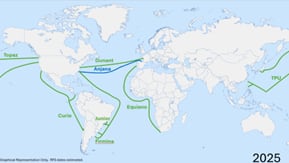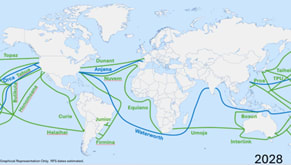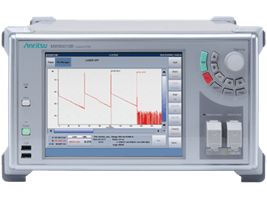Submarine networks are critical infrastructure, and demand is steadily growing on all undersea routes. Today, submarine cables carry over 99% of all intercontinental communications. Its importance in data transmissions means there is no tolerance for faults resulting in outages, which can lead to considerable financial loss and customer dissatisfaction, exacerbated by the fact that repairs often take place in one of the most challenging environments of all – at sea. This means design, installation, and maintenance processes mandate accurate and reliable testing, typically using a coherent OTDR (C-OTDR).
There are numerous reasons for the growth of submarine networks. At the top are Hyperscaler Internet Content Providers (ICPs), also known as hyperscalers, including Google, Amazon Web Services (AWS), Microsoft, and Meta. Each is operating enormous data centers all over the globe to best serve local customers. Hyperscalers are investing heavily in data centers, and the submarine networks that interconnect them, as well as utilizing wholesale operator networks, to satisfy the growing demand for their cloud services and critical data transmission across continents.
Submarine Cables Span the Globe
According to industry analyst TeleGeography, there are more than 600 planned and operational submarine cables spanning over 1.48 million km on the seabed. These cables can carry over 300 Tb/s of traffic today, and even higher in the near future. Cable lengths can be as short as less than 100 km and as long as nearly 40,000 km. The number of submarine cables is only going to increase, according to Pioneer Consulting’s Managing Partner, Gavin Tully, and public data (figure 1).


Figure 1: submarine cables in service by hyperscalers (left) and expected by 2028 (right).
Because of their long lengths, optical submarine cables use erbium-doped fiber amplifiers (EDFAs) every few tens of kilometers to amplify attenuated light. Transmission lines that span thousands of kilometers are connected using multiple EDFAs and branches.
Submarine cable networks typically also have Submarine Line Terminal Equipment (SLTE) from multiple vendors. This Open Cable system approach simplifies network element integration, allows for a broader and more resilient vendor supply chain, and facilitates easier capacity upgrades.
Wet Data Centers
Cables and SLTE are not the only network elements that must overcome ocean challenges. More hyperscalers are designing wet data centers, which involve installing data center components underwater, protected by a waterproof capsule. A wet data center enables more efficient data transmission, adds flexibility, and can reduce costs.
Construction and ongoing maintenance are trade-offs in the evolution of the submarine network. Comprehensive network management ensures the reliable transmission of critical data over the end-to-end network.
Maintaining submarine networks has added environmental challenges, as you can imagine. After all, submarine cables are on the ocean floor. While optical submarine cables are designed to withstand deep ocean issues, they can be severed by fishing gear, ship anchors, or natural disasters such as earthquakes.
Need for Coherent OTDR
A C-OTDR is important test equipment for submarine network operations and ongoing maintenance. A C-OTDR examines the optical submarine cable conditions by injecting an optical pulse into one end of the cable and using the backscatter light and Fresnel reflection of light returning to the C-OTDR after passage through the optical fiber.
It is particularly beneficial to verify EDFAs, which emit amplified spontaneous emission (ASE). To measure it effectively, the C-OTDR must be highly sensitive by adopting a coherent detection method that detects interference signals (Beat signal) caused by signal light (Backscatter) and reference light (Local light).
Integrated Test Solution
Anritsu’s MW90010B (figure 2) is a C-OTDR supporting a high dynamic range and short resolution, which can detect repeater (undersea optical amplifier) failures as well as cable faults. Traditional systems send commands for repeater evaluation only. The MW90010B supports Ciena’s PinPoint application, an application available with Ciena’s Navigator Network Control Suite™ (NCS). By doing so, users can implement a real-time, in-service, and detailed monitoring system on any submarine cable.
Figure 2: The Anritsu MW90010B C-OTDR detects repeater failures and cable faults.
In addition, the integrated MW90010B-PinPoint solution supports wet data centers. Fiber pairs on submarine cables are increasingly leveraging spatial division multiplexing (SDM) wet plant technology. The MW90010B-PinPoint solution is highly scalable in that the monitoring of all fiber pairs can be performed via optical switches. This approach is preferred over traditional systems that require a monitoring device attached to each fiber pair, which increases the cost of testing.
Simplified Operation
Ease of use is another necessity of a C-OTDR. Operator commands on the MW90010B are issued via a simple web-based GUI, so parameters such as channel, output power, and average time are easy to set. For example, it’s easy to select the test cable by simply changing the path of the optical switch. Flexible setup allows test schedules to be run daily, weekly, or annually.
A high-powered OTDR, featuring 10 ms resolution and a wide dynamic range of up to 26 dB, enables the MW90010B to meet the requirements of current submarine cable analysis. It measures optic cable characteristics, such as loss, distance to faults, and the location of connectors or splices, on submarine cables up to 20,000 km with a 10 ms resolution.

















